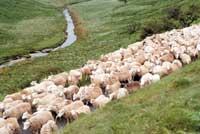History of domesticated animals
The other day we talked about the origin of domesticated horses. In one place no, but we mention that in many places they were domesticated at once. This time we will talk about cattle, pork and sheep.

To know when the domestication of animals occurred, researchers use mitochondria DNA. The DNA of the mitochondria varies very little from generation to generation, so they are very useful to follow the branches of the species. Those with the same mitochondrial DNA have the same origin, while those with very different DNA have different origin. That is, although two specimens belong to the same species, one is a descendant of a variety developed in Japan and the other is after that developed in Peru through the DNA of the mitochondria.
In 1994, researchers at Trinity College Dublin investigated the DNA of modern patrol mitochondria and concluded that they were twice domesticated, and that domestication took place in two places thousands of kilometers.
Now, after analyzing the DNA of modern pig and sheep mitochondria, they have seen that they were also twice domesticated. Both cattle and sheep and pigs show the same surprising differences in every corner of the world. In all three cases, two main types of mitochondrial DNA appear. That is, taking the pigs as an example, looking at the DNA of the mitochondria there are pigs of class A and B. The same goes for sheep and cattle.
DNA analyses suggest that cattle were domesticated 8,000-10,000 years ago, some in the area of Turkey, Jordan and Iraq and others in India. Sheep were also first domesticated in these regions. On the contrary, pigs, some in the Turkey area, yes, but others are believed to have been domesticated by China. Surprisingly, cattle, swine and domesticated sheep currently around the world seem to come from two different and specific "sources."
Buletina
Bidali zure helbide elektronikoa eta jaso asteroko buletina zure sarrera-ontzian











